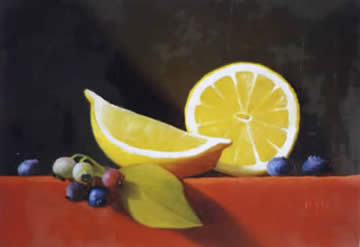|
THE TECHNIQUE OF
MONOCHROME AND COLOR UNDERPAINTING

|
Indirect painting methods are
infinitely variable and can be executed with few or many colors and
layers of paint. The following images serve as one example of
a small traditional still-life painting executed with an
underpainting. This painting was painted in several layers, working
from the general to the specific, dark to light and transparency to
opaqueness. |
|
|
|
1. The canvas was toned with a neutral
color. The composition of the setup was then laid out in a semi
circle, indicating the overall position of each
object. |
| |
|
|
|
|
|
2. During the following step all the
shadows within the composition were defined through transparent
layers of paint. This included all shadow areas on the objects,
shadows cast by the objects as well as the shadow on the
wall. |
| |
|
|
|
|
|
3. After all shadows were laid down; the
areas of light were defined by adding the local color in an alla
prima fashion. The light was first applied to the background, and
followed by the table and the objects towards the front of the
painting. |
| |
|
|
|
|
|
4. In step four more delicate transparent
areas of light (inner part of the lemon) were defined, followed by
the blueberries and the green leaf. |
| |
|
|
|
|
|
5. The final layers were added in step
five. Here several layers of opaque and transparent colors
were applied to give this painting its quality of delicate
transitions of color, light and
shadow. |
|
Depending on the technique,
the subject matter and the quality of the finale painting
envisioned, it is advisable to let the different layers of paint dry
thoroughly before successive layers of paint are applied.
Unfortunately the subtle layers of paint are showing up poorly in
reproductions. |
NO FORM OF
REPRODUCTION HAS SUFFICIENT QUALITY TO REPLACE
AN ORIGINAL WORK OF
ART!
Copyright 2025 Marlies Ihmels. All rights
reserved.
|
